Carvana Business Model Canvas 2024
Revolutionizing the car-buying experience with an innovative online platform that seamlessly integrates technology, convenience, and transparency, Carvana has emerged as a disruptive force in the automotive industry, challenging traditional dealership models while offering customers an unparalleled level of control and convenience. In this Carvana Business Model Canvas, I will identify its customer segments, value proposition, revenue streams, channels, customer relationships, key activities, key resources, key partners, and cost structure.
Interesting fact!
Carvana’s car vending machines are not just for show – they’re fully automated and use advanced robotics and technology to efficiently retrieve and deliver vehicles to customers.
Carvana Competitors
Vroom | CarMax | Shift | Autonation | TrueCar | Cars.com | Autotrader | KBB.com | CarGurus
Customer Segments – Carvana Business Model Canvas
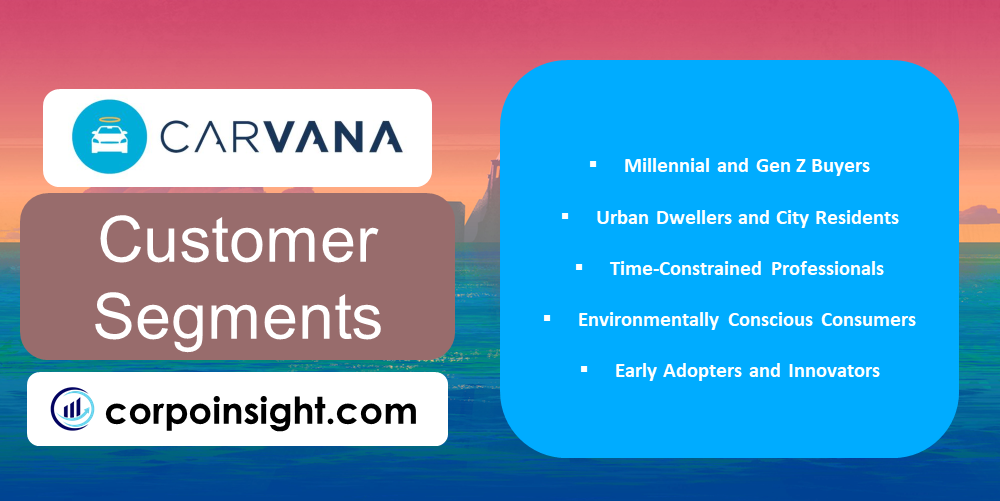
1. Millennial and Gen Z Buyers: As digital natives, these tech-savvy generations have embraced Carvana’s online car-buying experience, which aligns with their preference for convenience, transparency, and a seamless integration of technology into their purchasing decisions.
2. Urban Dwellers and City Residents: For those residing in densely populated urban areas, where traditional dealerships may be inconvenient or scarce, Carvana’s online platform and doorstep delivery services have proven to be an attractive option, catering to their unique needs and lifestyle.
3. Time-Constrained Professionals: With demanding careers and busy schedules, many working professionals have found solace in Carvana’s efficient and hassle-free car-buying process, which eliminates the need for lengthy negotiations and allows them to make informed decisions from the comfort of their homes or offices.
4. Environmentally Conscious Consumers: By offering an online platform and facilitating home deliveries, Carvana appeals to eco-friendly consumers who value minimizing their carbon footprint and reducing the need for multiple trips to physical dealerships.
5. Early Adopters and Innovators: As a disruptive force in the automotive industry, Carvana has attracted early adopters and innovators who appreciate the company’s commitment to revolutionizing the car-buying experience through cutting-edge technology and innovative business models.
Value Proposition – Carvana Business Model Canvas
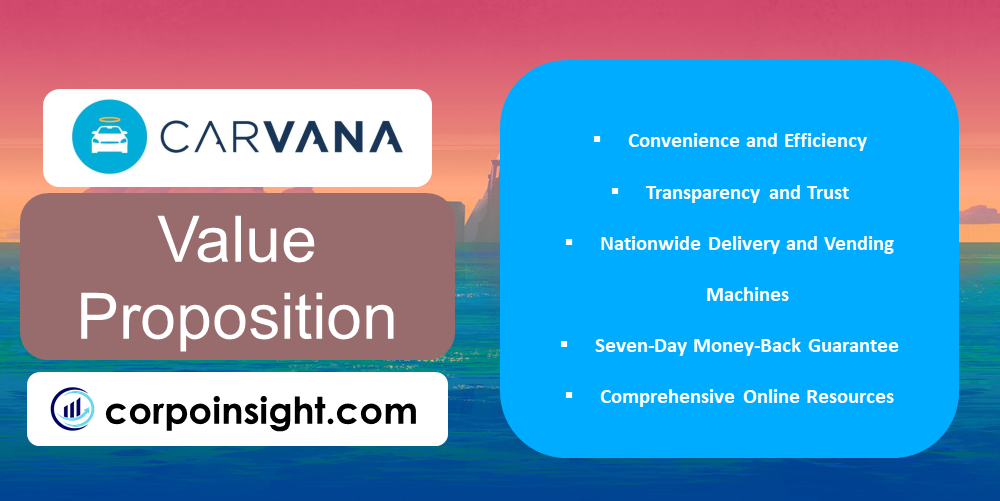
1. Convenience and Efficiency: By offering an entirely online car-buying experience, Carvana eliminates the need for time-consuming visits to physical dealerships, allowing customers to browse, purchase, and even trade in their vehicles from the comfort of their homes or offices.
2. Transparency and Trust: Carvana’s commitment to transparency is evident in its detailed vehicle history reports, high-resolution 360-degree virtual tours, and a no-haggle pricing model, fostering trust and enabling customers to make informed decisions without the traditional negotiation hassles.
3. Nationwide Delivery and Vending Machines: Carvana’s innovative delivery methods, including doorstep delivery and its iconic car vending machines, provide customers with a unique and memorable experience, setting the company apart from traditional dealerships.
4. Seven-Day Money-Back Guarantee: Carvana’s confidence in its offerings is reflected in its seven-day money-back guarantee, which allows customers to return their purchased vehicle for any reason within the specified period, minimizing risk and enhancing customer satisfaction.
5. Comprehensive Online Resources: Carvana’s user-friendly website and mobile app offer a wealth of resources, including financing options, trade-in tools, and educational content, empowering customers throughout the car-buying journey and fostering a sense of control and ownership over the process.
Revenue Streams – Carvana Business Model Canvas
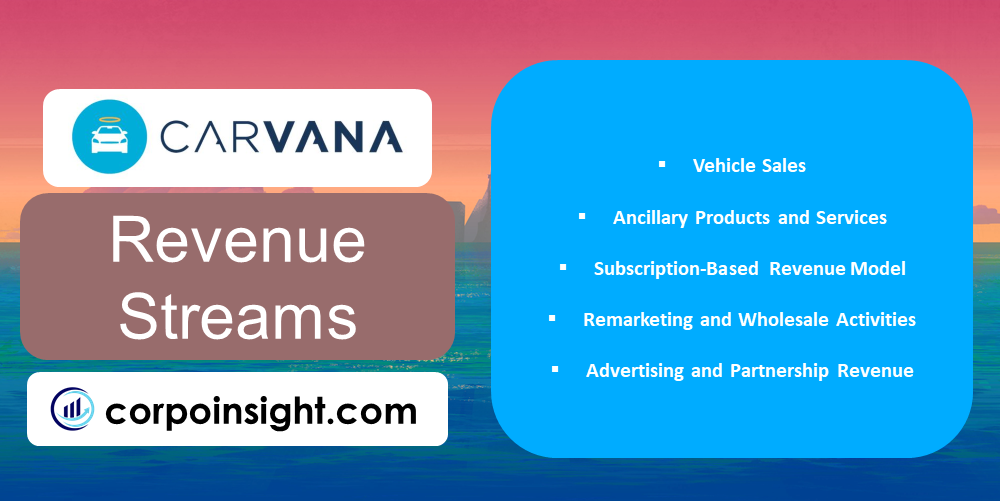
1. Vehicle Sales: Carvana’s primary revenue source is the sale of used vehicles through its online platform, where customers can browse, purchase, and arrange for delivery or pickup of their desired cars, generating substantial revenue for the company.
2. Ancillary Products and Services: In addition to vehicle sales, Carvana offers a range of ancillary products and services, such as vehicle protection plans, financing options, and trade-in services, which contribute to its overall revenue streams and provide customers with a comprehensive car-buying experience.
3. Subscription-Based Revenue Model: Carvana has introduced a subscription-based revenue model, allowing customers to access a diverse selection of vehicles for a monthly fee, potentially opening up new avenues for recurring revenue and catering to customers seeking flexibility and variety.
4. Remarketing and Wholesale Activities: Carvana’s remarketing and wholesale activities, which involve the sale of vehicles to other dealers or at auction, provide an additional revenue stream by maximizing the value of its inventory and enabling efficient inventory management.
5. Advertising and Partnership Revenue: By leveraging its online presence and customer base, Carvana can generate revenue through advertising partnerships, sponsored content, and affiliate marketing programs, diversifying its revenue streams and capitalizing on its digital footprint.
Channels – Carvana Business Model Canvas
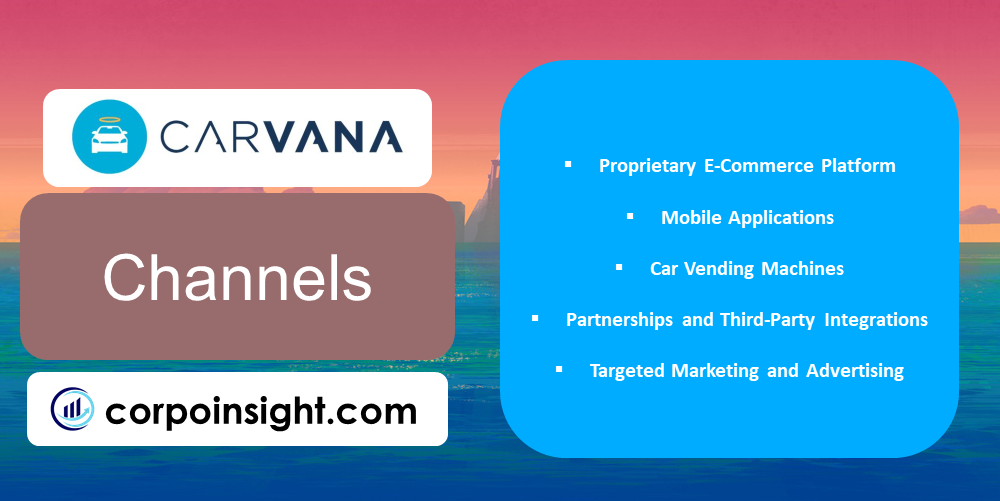
1. Proprietary E-Commerce Platform: Carvana’s primary channel is its user-friendly, feature-rich e-commerce platform, which serves as a digital showroom where customers can seamlessly browse, research, and purchase vehicles from the convenience of their devices, facilitating a streamlined and efficient car-buying experience.
2. Mobile Applications: Recognizing the growing importance of mobile devices, Carvana has developed intuitive and user-friendly mobile applications, enabling customers to access its services and complete transactions on the go, providing a consistent and cohesive experience across multiple channels.
3. Car Vending Machines: Carvana’s innovative car vending machines, located in various metropolitan areas, serve as unique and visually striking channels that allow customers to pick up their purchased vehicles memorably and engagingly, blending technology with a touch of theatricality.
4. Partnerships and Third-Party Integrations: Carvana leverages partnerships and third-party integrations with various platforms and services, such as finance providers, insurance companies, and automotive-related websites, expanding its reach and providing customers with a seamless and integrated experience throughout the car-buying journey.
5. Targeted Marketing and Advertising: To reach and engage with potential customers, Carvana employs targeted marketing and advertising strategies across various digital and traditional channels, including social media, search engines, and relevant online platforms, ensuring its offerings are visible and accessible to its target audience.
Customer Relationships – Carvana Business Model Canvas

1. Self-Service Online Experience: Carvana’s business model revolves around empowering customers with a self-service online experience, where they can independently research, evaluate, and complete transactions without the need for traditional salesperson interactions, fostering a sense of control and autonomy throughout the car-buying process.
2. Personalized Recommendations and Virtual Assistance: Utilizing advanced algorithms and data analytics, Carvana provides personalized recommendations and virtual assistance to customers, tailoring the experience to their specific preferences, driving behavior, and vehicle requirements, creating a more engaging and relevant interaction.
3. Comprehensive Support and Resources: Despite the self-service nature of its platform, Carvana offers comprehensive support and resources to its customers, including knowledgeable customer service representatives, educational materials, and robust online communities, ensuring that customers feel supported and informed throughout their journey.
4. Seven-Day Money-Back Guarantee: Carvana’s seven-day money-back guarantee fosters a strong customer relationship built on trust and confidence, as customers can return their purchased vehicle within the specified period if they are not entirely satisfied, mitigating risk and promoting a stress-free experience.
5. Loyalty and Retention Programs: To cultivate long-lasting relationships and encourage repeat business, Carvana has implemented loyalty and retention programs, offering incentives, exclusive offers, and personalized experiences to its existing customer base, reinforcing its commitment and fostering a sense of community among its loyal customers.
Key Activities – Carvana Business Model Canvas
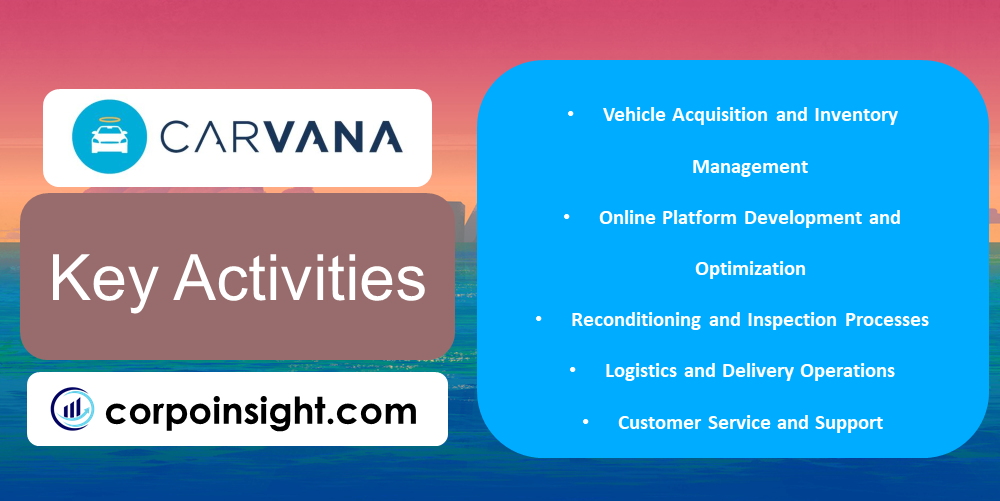
1. Vehicle Acquisition and Inventory Management: Carvana’s success hinges on its ability to acquire high-quality used vehicles through various channels, such as trade-ins, auctions, and partnerships, while employing sophisticated inventory management strategies to ensure a diverse and desirable selection for its customers.
2. Online Platform Development and Optimization: Carvana’s core operations revolve around the continuous development and optimization of its user-friendly online platform, incorporating cutting-edge technologies, enhancing the user experience, and integrating seamless processes for vehicle browsing, purchasing, and delivery.
3. Reconditioning and Inspection Processes: To maintain its reputation for quality and transparency, Carvana undertakes rigorous reconditioning and inspection processes for each vehicle in its inventory, ensuring they meet stringent standards before being listed for sale, fostering customer confidence and trust.
4. Logistics and Delivery Operations: Carvana’s innovative delivery methods, including doorstep delivery and its iconic car vending machines, necessitate robust logistics and delivery operations, requiring meticulous planning, coordination, and execution to provide customers with a seamless and memorable experience.
5. Customer Service and Support: Recognizing the importance of exceptional customer service, Carvana invests significant resources into training and maintaining a knowledgeable and responsive customer support team, capable of addressing inquiries, resolving issues, and ensuring a positive overall experience for its customers.
Key Resources – Carvana Business Model Canvas
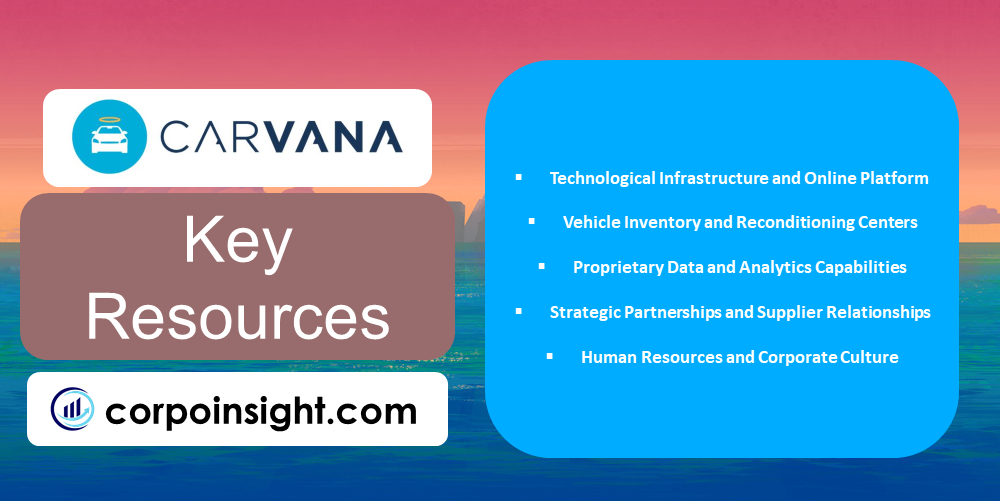
1. Technological Infrastructure and Online Platform: Carvana’s robust technological infrastructure and user-friendly online platform serve as the backbone of its operations, enabling seamless vehicle browsing, purchasing, and delivery processes, while integrating various features and functionalities to enhance the customer experience.
2. Vehicle Inventory and Reconditioning Centers: Carvana’s extensive vehicle inventory and state-of-the-art reconditioning centers are critical resources that ensure a steady supply of high-quality used vehicles, meticulously inspected and prepared for sale, meeting the discerning standards of its customer base.
3. Proprietary Data and Analytics Capabilities: Leveraging proprietary data and advanced analytics capabilities, Carvana gains valuable insights into customer preferences, market trends, and operational efficiencies, empowering the company to make informed decisions, optimize processes, and deliver personalized experiences.
4. Strategic Partnerships and Supplier Relationships: Carvana’s strategic partnerships with various suppliers, finance providers, and automotive-related companies enable access to a diverse range of resources, including vehicle acquisition channels, ancillary products and services, and specialized expertise.
5. Human Resources and Corporate Culture: Carvana’s dedicated team of skilled professionals, combined with a corporate culture that fosters innovation, customer-centricity, and continuous improvement, serves as a valuable resource, driving the company’s success and propelling it toward achieving its strategic objectives.
Key Partners – Carvana Business Model Canvas
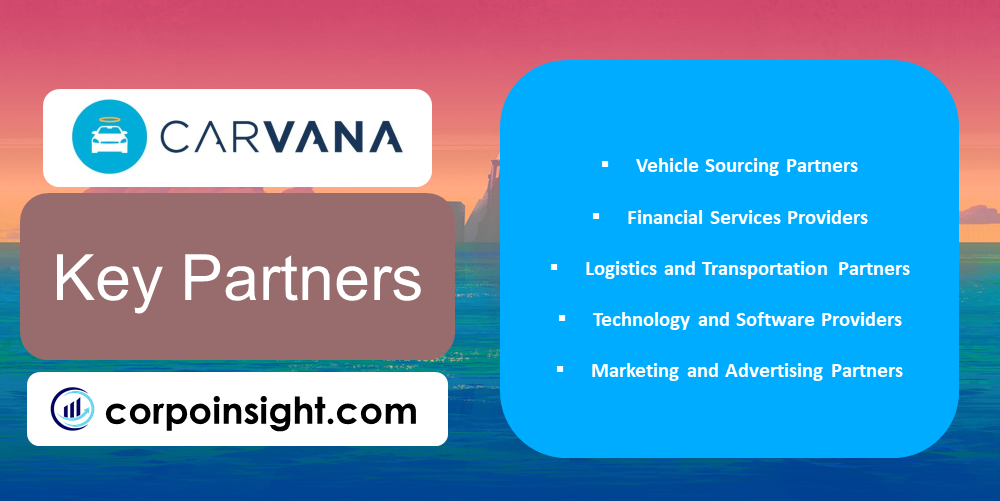
1. Vehicle Sourcing Partners: Carvana collaborates with a network of vehicle sourcing partners, including auctions, dealerships, and rental car companies, ensuring a steady supply of high-quality used vehicles to fuel its inventory and meet customer demand across various makes and models.
2. Financial Services Providers: To offer a comprehensive car-buying experience, Carvana partners with reputable financial services providers, such as banks, credit unions, and lenders, allowing customers to access competitive financing options and facilitate seamless transactions.
3. Logistics and Transportation Partners: Carvana’s doorstep delivery and innovative car vending machines require strategic partnerships with logistics and transportation companies, enabling efficient and reliable vehicle delivery services across the nation while maintaining a high level of customer satisfaction.
4. Technology and Software Providers: As a technology-driven company, Carvana leverages partnerships with leading technology and software providers to enhance its online platform, integrate advanced features, and ensure the continued optimization of its digital infrastructure and customer-facing applications.
5. Marketing and Advertising Partners: Carvana collaborates with various marketing and advertising agencies, as well as digital platforms and influencers, to effectively promote its brand, reach targeted audiences, and drive customer acquisition through strategic marketing campaigns and initiatives.
Cost Structure – Carvana Business Model Canvas
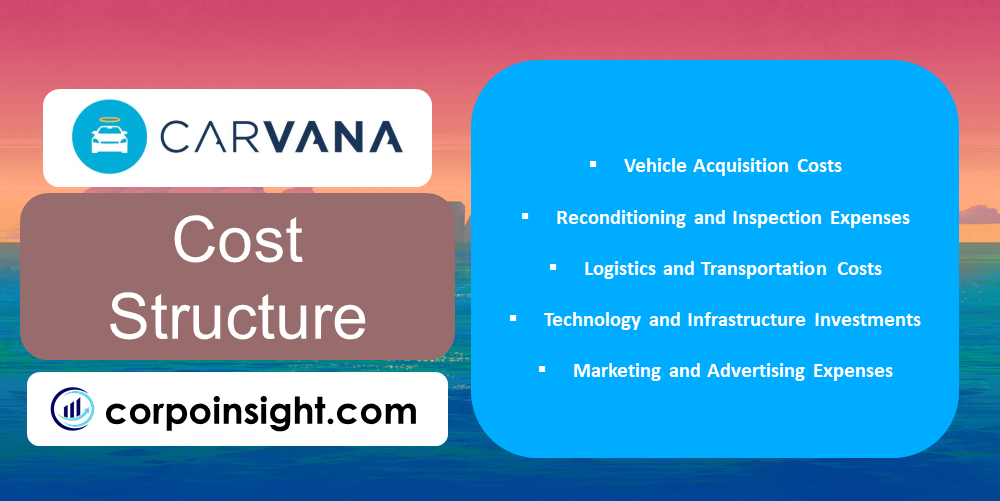
1. Vehicle Acquisition Costs: A significant portion of Carvana’s cost structure is dedicated to acquiring high-quality used vehicles through various channels, including auctions, trade-ins, and partnerships, as maintaining a desirable and diverse inventory is crucial for its business model.
2. Reconditioning and Inspection Expenses: To ensure customer satisfaction and maintain its reputation for transparency, Carvana invests substantial resources in reconditioning and meticulously inspecting each vehicle, incurring costs related to labor, facilities, and equipment utilized in the process.
3. Logistics and Transportation Costs: Carvana’s innovative delivery methods, such as doorstep delivery and the iconic car vending machines, necessitate significant expenditures associated with logistics and transportation, including fuel, maintenance, and personnel expenses, to provide customers with a seamless and efficient experience.
4. Technology and Infrastructure Investments: As a technology-driven company, Carvana must continuously invest in its technological infrastructure, online platform, and digital capabilities, incurring costs for software development, data storage, and cybersecurity measures to maintain a competitive edge and deliver a superior user experience.
5. Marketing and Advertising Expenses: To effectively promote its brand, reach new customers, and drive growth, Carvana allocates a substantial portion of its budget towards marketing and advertising campaigns across various digital and traditional channels, leveraging strategic partnerships and targeted initiatives.
Summary of Carvana Business Model Canvas

Conclusion on Carvana Business Model Canvas
In conclusion, Carvana’s business model canvas highlights its innovative approach to disrupting the traditional car-buying experience. By leveraging technology, offering a seamless online platform, and providing unique delivery methods, Carvana has carved a niche for itself in the automotive industry. Its focus on customer convenience, transparency, and a streamlined process has resonated with modern consumers, positioning the company for continued growth and success in the ever-evolving digital landscape.

This is Ahsanul Haque, someone very passionate about digital marketing, SEO, and Data Analytics and founder of the Analytics Empire and currently pursuing my major in marketing at Bangladesh University of Professionals.






